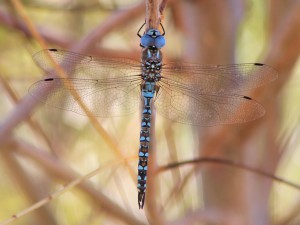Blue-eyed Darners (Rhionaeschna multicolor) are common throughout California. This dragonfly is a mosaic darner. This mosaic darner family contains at least 10 species, all of relatively similar size and coloration. Hence, mosaic darners are often quite hard to tell apart. The family gets its name from the beautiful pattern of coloration on the abdominal segments. The broad distribution of Blue-eyed Darners extends from central Canada south, across most of the United States and all the way down to Panama in Central America. Furthermore, the completely blue eyes and absence of a black line dividing the face distinguish Blue-eyed Darner from all other members of the family. They also differ in the shape of the abdominal appendages.
Finding the Blue-eyed Darner
The Blue-eyed Darner is a fairly large dragonfly, ranging from 2.5 to 3.0 inches in length. Typically, they hunt smaller flying insects on the wing, which they catch in the spiky basket formed by their legs. During flight seasons, you can find a Blue-eyed Darner patrolling over a broad area of 25 to 50 yards in length. They are territorial, and aggressively harass other dragonflies that encroach on their turf. Thus, they are easy to find, but difficult to photograph! This Blue-eyed Darner was cruising over a flooded drainage ditch near Big Bear Lake in the San Bernardino Mountains. I noticed it hovering repeatedly in one area, and captured it with a Canon EOS Rebel T3 camera and a 100-400 mm IS zoom lens.
Photographing Blue-Eyed Darners
Usually, Blue-eyed Darners seldom perch for long, especially during the heat of the day. This individual dangled from a cottonwood tree in Imperial County, California, last October. This photograph was digiscoped with a Swarovski ATX-65 spotting scope and a Canon 40D camera, using the Swarovski TLS-APO adaptor.


